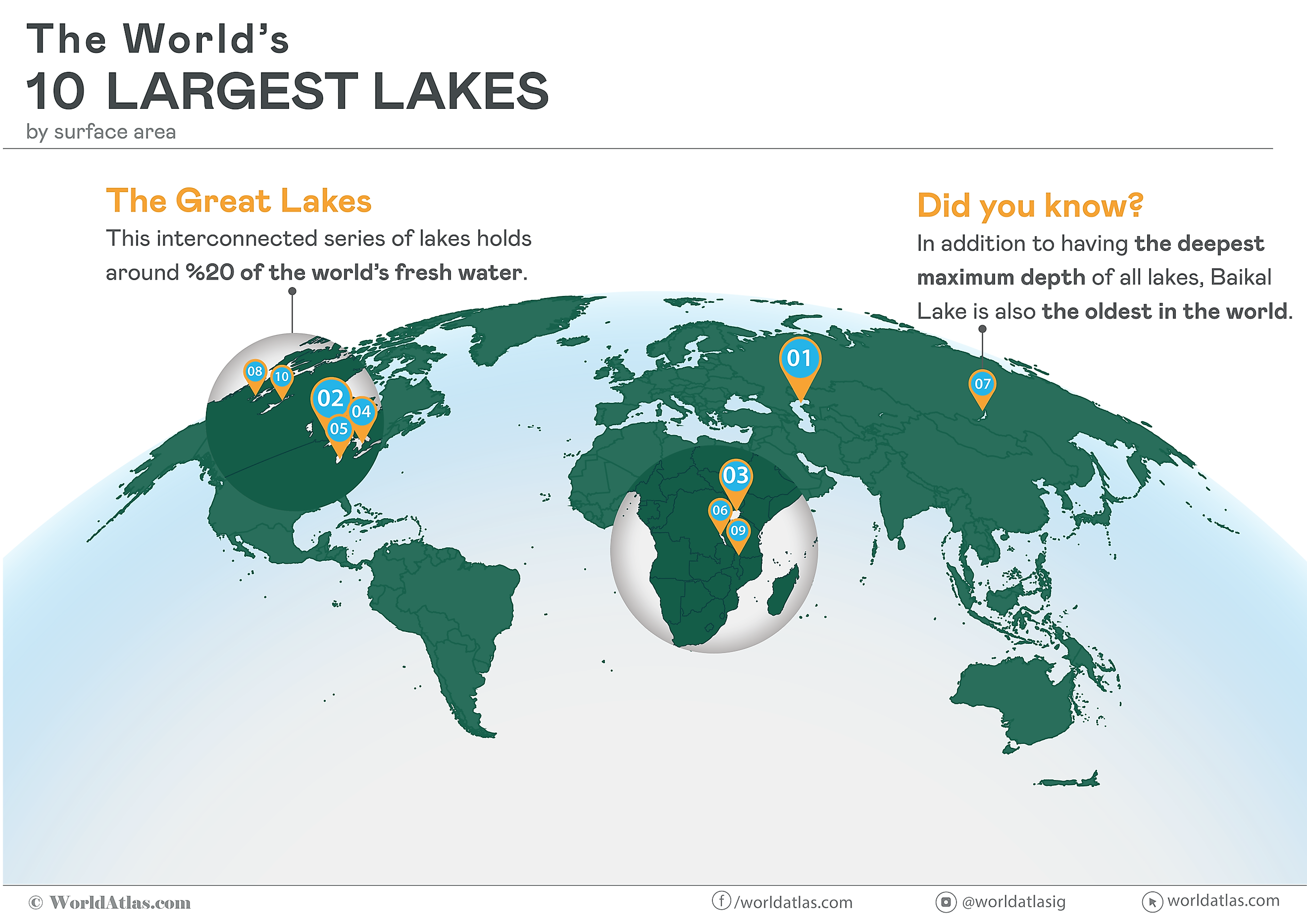
The 10 Largest Lakes In The World
Three percent: that is the amount of water on Earth that is freshwater, a defining feature of lakes, and the only water that is drinkable or useful for agriculture. Clearly, if lakes are primary sources of freshwater, there is an imperative to study and maintain them for the sake of the present and the future. Yet, not all lakes are equal in terms of size, and some of the lakes on this list contain up to 20% of the world's unfrozen water reserves! More evidently, the Great Lakes of North America refuse to be grouped into one entity, so they occupy four of the top ten spots in this collection. So, read on to check out the most stunning bodies of freshwater (with one notable exception) that this planet possesses.
- Caspian Sea
- Lake Superior Lake
- Victoria Lake
- Huron Lake
- Michigan Lake
- Tanganyika Lake
- Baikal Lake
- Great Bear Lake
- Malawi Lake
- Great Slave Lake
What is the Difference Between a Lake and a Sea?
A lake is an inland body of standing water, usually fresh, formed by natural processes like glacial, tectonic, or volcanic activity, or by human activities like damming. It is generally smaller than a sea and closed off from larger water bodies. A sea, on the other hand, is a large body of saltwater partially enclosed by land but connected to an ocean. Seas are larger and deeper than lakes and influenced by tides. Notably, these terms are often disputed, and locations like the Dead Sea (which is considered a salt lake) further blur the lines.
The Caspian Sea is another exception; it is called a "sea" but classified as a lake. Despite its salt water, it is landlocked and not connected to any ocean. It is also the world's largest lake by surface area. Its name might be a historical artifact or possibly because of its large size and saltiness. But scientifically speaking, its isolation from the world's oceans makes it a lake.
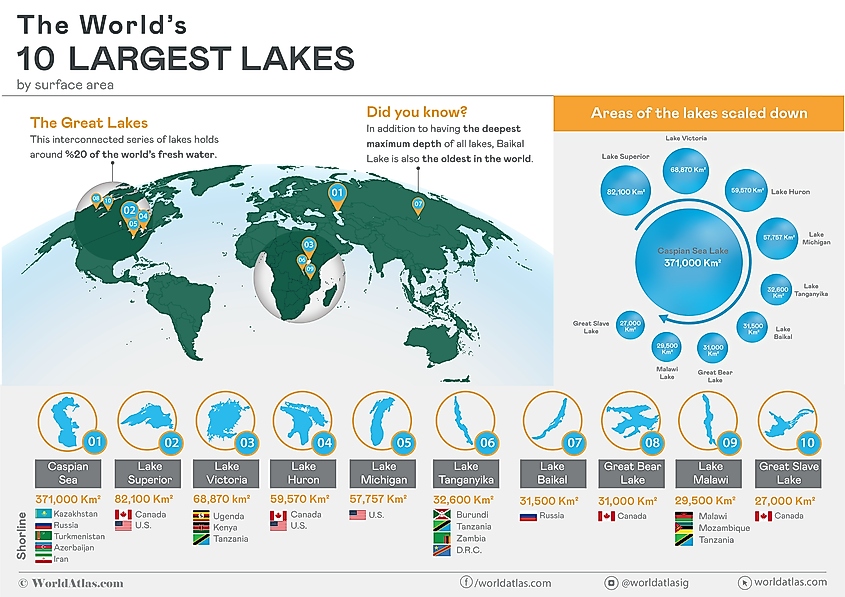
1. Caspian Sea - 371,000 km2
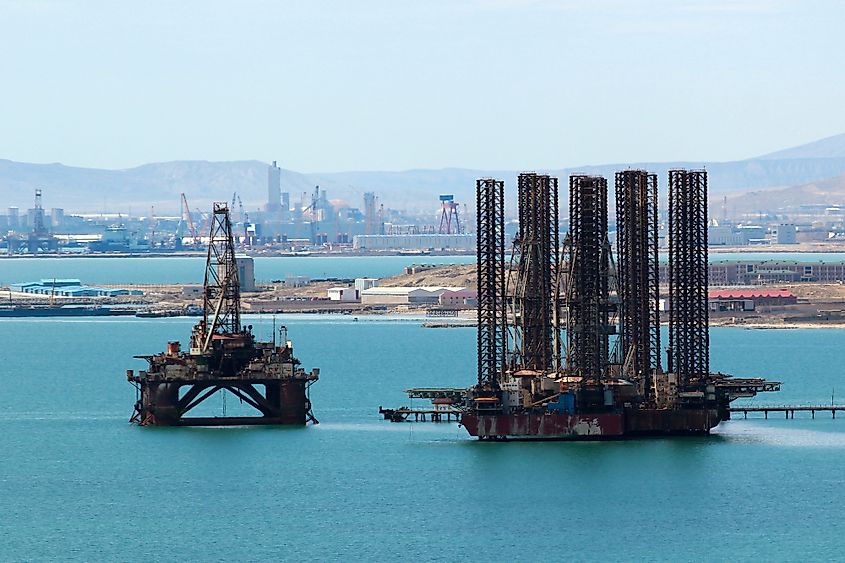
The Caspian Sea has acted as a pillar of human industry and culture for countless centuries; this gargantuan lake spans 371,000 km2 (143,243 mi2) making it the world's largest enclosed inland body of water. Furthermore, its massive area not only serves as a boundary between Europe and Asia but it also manages to influence climatic conditions and all surrounding ecosystems. Despite being referred to as a "sea," it is technically also a lake with both saltwater and freshwater characteristics. Its length stretches approximately 1,200 km (745 mi) from north to south, while its width averages 320 km (200 mi). 130 rivers are responsible for feeding into the Caspian Sea, the most significant being the Volga River. Its considerable size plays a role in regional geopolitics, touching five countries: Russia, Kazakhstan, Turkmenistan, Iran, and Azerbaijan. The sea's extensive shoreline, differentiating from rocky cliffs to flatlands, impacts surrounding habitats and human activities like fishing and oil extraction. This ultimately means the Caspian Sea is a critical waterway for trade, and it also possesses substantial oil and gas reserves.
2. Lake Superior - 82,103 km2
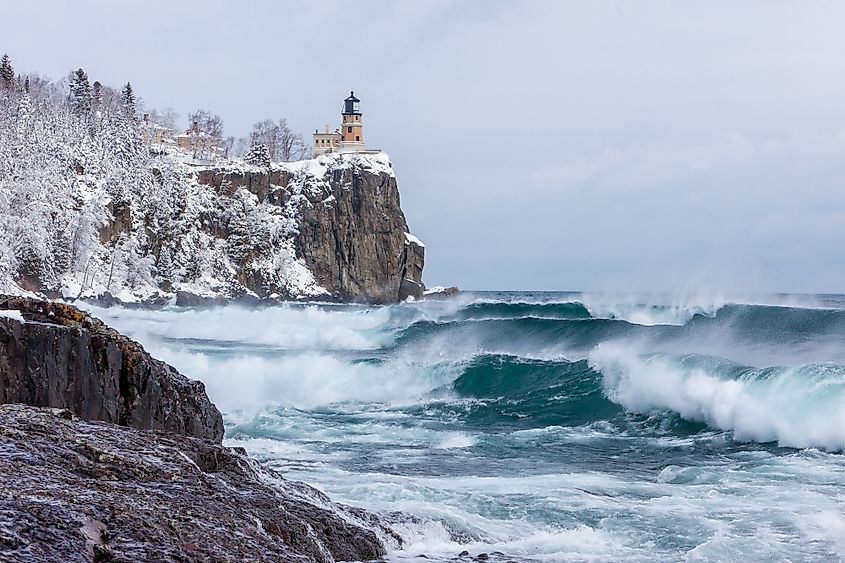
The nearly mythological-in-scale Lake Superior is the largest of the Great Lakes in North America, covering an expansive area of 82,103 km2 (31,700 mi2). Due to its vast dimensions, it ranks as the biggest freshwater lake in terms of surface area and comes in third when considering volume. Geographically, it is bounded by the United States to the south and Canada to the north. Its colossal size creates microclimates that affect vegetation and animal habitats around its shores. The lake has significant depths, with an average depth of 152 m (500 ft) and a maximum of 406 m (1,332 ft), allowing for cold, well-oxygenated water layers. Its vastness also means it has a retention time of about 191 years, meaning each drop of water stays in the lake for this extended period, affecting nutrient cycles and aquatic life. Major cities like Duluth and Thunder Bay sit on its shores, benefiting from shipping routes facilitated by the lake's connection to the Atlantic Ocean via the St. Lawrence Seaway.
3. Lake Victoria - 69,484 km2
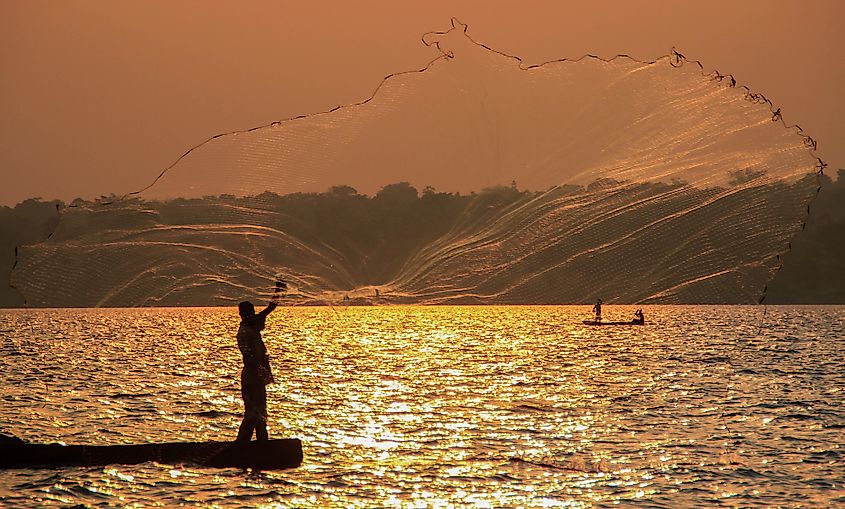
A truly monolithic body of freshwater, Lake Victoria covers 69,484 km2 (26,828 mi2) in East Africa. Her shores are shared by Uganda, Kenya, and Tanzania. It is the world's second-largest freshwater lake by surface area and plays a pivotal role in the region's hydrology, acting as one of the major sources for the Nile River. The size of the lake aids in generating localized rain systems; because of this, its shores are densely populated, benefitting from the temperate climate and the availability of water for agriculture. However, this activity and development also subject the lake to pollution and overfishing, challenging its ecological balance. The lake's large area also affects transportation; it is a vital waterway that enables trade and movement between the countries bordering it. Although it is quite large, the lake is not very deep, having an average depth of 40 meters or 130 feet.
4. Lake Huron - 59,590 km2
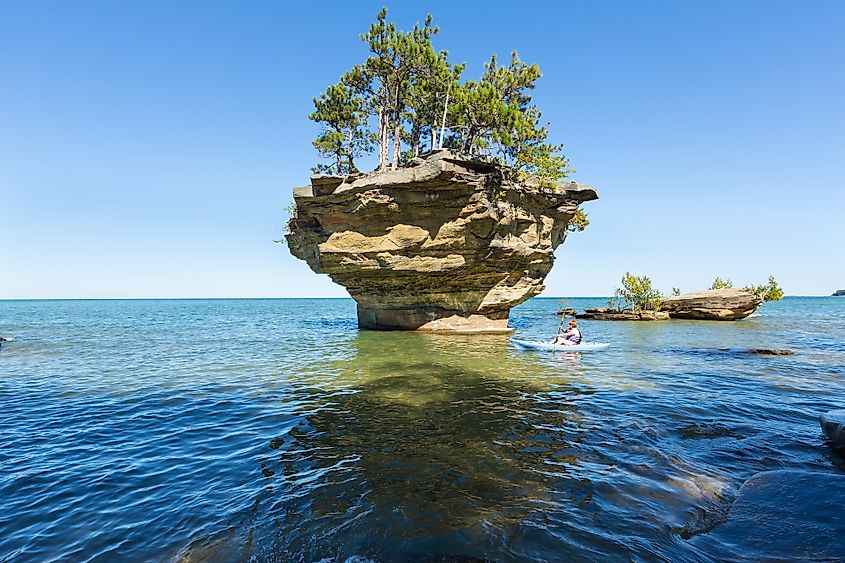
They are not called the "Great Lakes" for nothing — Lake Huron, with a surface area of 59,590 km2 (23,007 mi2), stands as the second-largest among North America's Great Lakes. Like many of the previous lakes, its size means it is influential on local weather patterns and on the overall diversity of the area. Situated primarily between the United States and Canada, Lake Huron aids industry and acts as a commercial fishing hub. Its 30,000 islands, the most famous being Manitoulin Island, also contribute to its geographic complexity, adding additional habitats and influencing water currents. Both Manitoulin and various bays, such as Saginaw and Georgian Bay, are centers of historical events for indigenous people groups. Last but not least, there are a number of fascinating formations like Turnip Rock that give the lake a distinct personality.
5. Lake Michigan - 57,753 km2
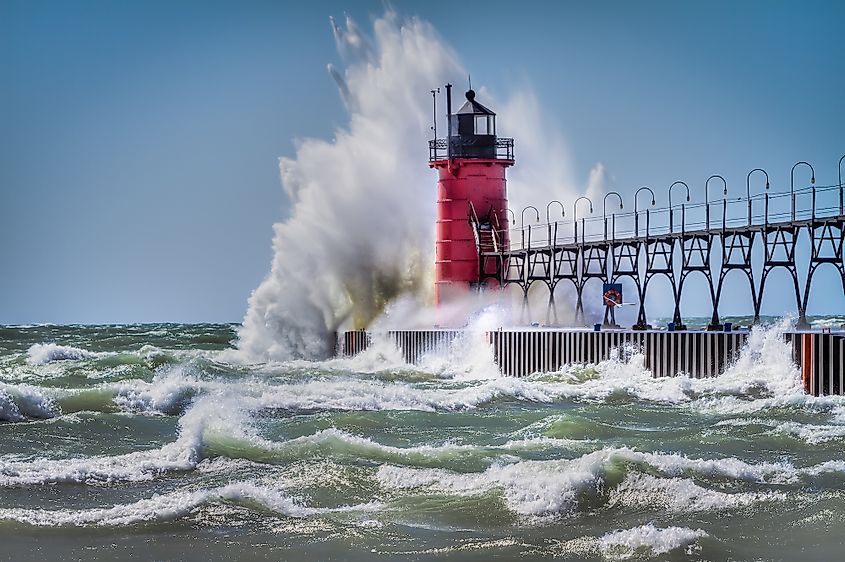
No list of the greatest lakes in the world would be complete without Lake Michigan, which has a water area of 57,753 km2 (22,298 mi2). This fiercesome deep is one of the five Great Lakes of North America and the only one located entirely within the United States. Its lengthy coastline, exceeding 1,600 miles, touches multiple states, including Michigan, Indiana, Illinois, and Wisconsin. The lake serves as a major conduit for shipping and travel, with important ports like Chicago and Milwaukee along its shores. Hydrologically, the lake connects to Lake Huron via the Straits of Mackinac, sharing water levels and making them technically one lake, but this is a point of discussion rather than a universally accepted fact. Numerous rivers, like the Fox-Wolf and Grand, feed into Lake Michigan, which helps maintain the massive drainage basin. On an interesting last note, roughly 750 ships have met their untimely fate in the storms and strength of Lake Michigan, a sign that not all lakes are gentle and simple to traverse.
6. Lake Tanganyika - 32,900 km2
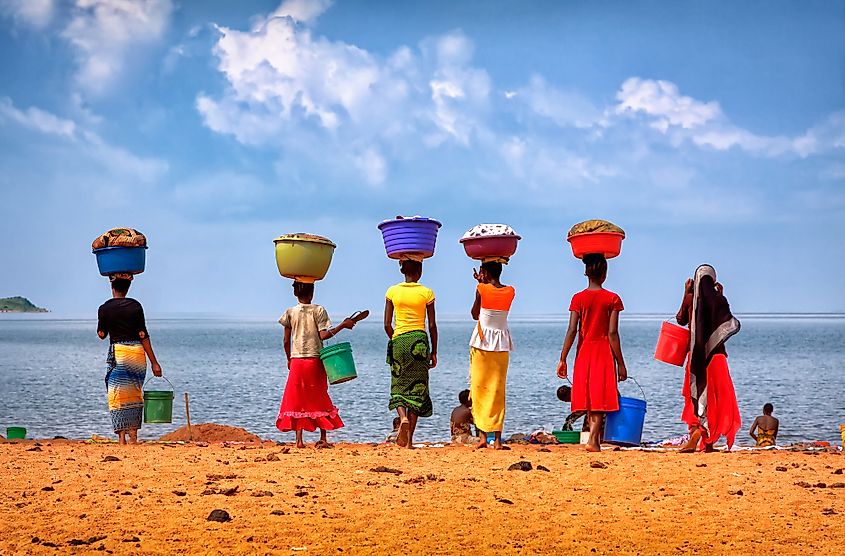
As the lake is observable from outer space (or Google Maps), anybody examining Lake Tanganyika will notice its most distinguishing feature: its length. As the world's longest freshwater lake, it stretches across four African countries: Burundi, the Democratic Republic of the Congo, Tanzania, and Zambia. Measuring 32,900 km2 (12,702 mi2), its depth reaches an astonishing 1,470 m (4,822 ft), making it the second-deepest globally. Remarkably, the lake is also one of the world's oldest freshwater bodies, with an estimated age of 9 to 12 million years. This ancient origin contributes to its distinct geology, characterized by steep, rocky shorelines and informative sediment layers.
Artisanal fishing, particularly of species like sleek lates and Tanganyika sardines, is a significant staple in the local economy. Water extraction for municipal and industrial use is another essential function. Despite its utility, the lake presents challenges such as bilharzia, a parasitic disease affecting local communities. Waterborne diseases from untreated waters here are an issue that needs to be confronted sooner rather than later.
7. Lake Baikal - 31,722 km2
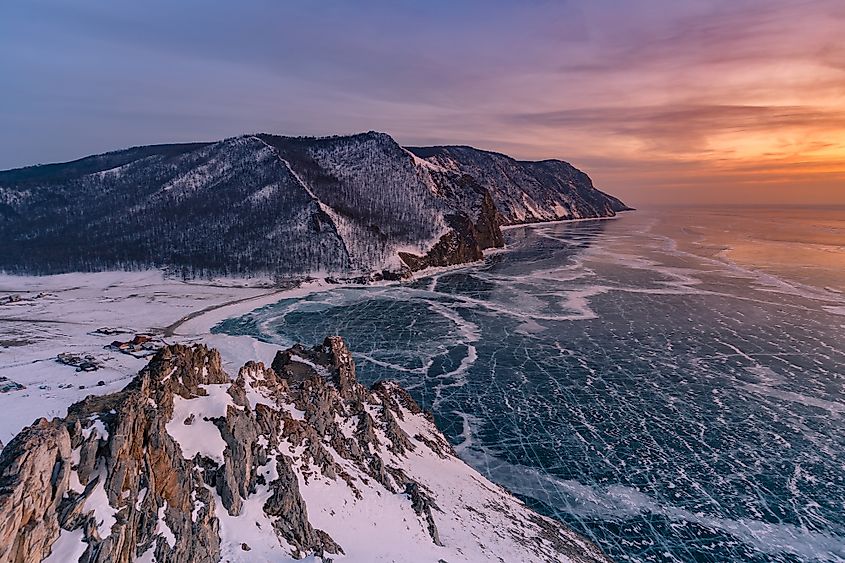
Lake Baikal, in southern Siberia and Russia, is an astounding geographical feature. Covering 31,722 km2 (12,247 mi2), it holds the title of the world's deepest freshwater lake, with depths that plunge up to 1,642 m (5,387 ft). The lake is also a biological hotspot, hosting over 1,700 species of plants and animals, two-thirds of which are found nowhere else. Historically, the lake holds a sacred status among local indigenous communities like the Buryats, who have lived in the adjacent regions for centuries.
Dating back to the Mesozoic era around 25 million years ago, Lake Baikal is among Earth's most ancient lakes. Geologically, its basin belongs to the Baikal Rift Zone, an active continental rift that is widening by about 2 centimeters annually. The bed of the lake mainly consists of sedimentary rocks such as limestone and dolomite, as well as metamorphic rocks like gneiss. From a hydrological perspective, the lake holds roughly 20% of Earth's unfrozen freshwater reserves, marked by exceptional clarity due to minimal suspended organic and inorganic matter. Seasonally, the lake freezes between January and May, and the ice can achieve a thickness of up to 1.4 meters.
8. Great Bear Lake - 31,328 km2
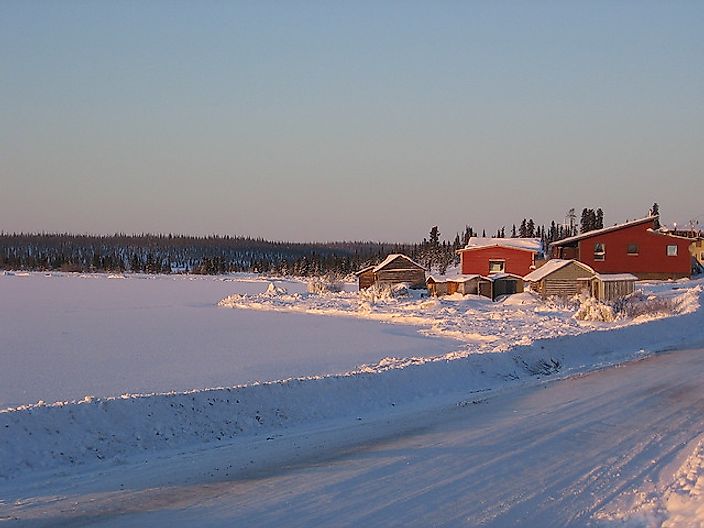
Put on a jacket because this lake lies in the frigid and remote regions of Canada's Northwest Territories. The reason Great Bear Lake qualifies for this collection is because it has an area of 31,328 km2 (12,095 mi2), making it the fourth-largest freshwater lake by volume and the eighth-largest by area in the world. To add to its fame, Great Bear Lake has an extreme depth of up to 446 m (1,463 ft).
The lake's isolation from human settlements minimizes anthropogenic impacts, making it one of the world's cleanest lakes (oof — we need to do better). Its clarity allows sunlight to penetrate deep into the water column, providing an optimal environment for photosynthetic organisms like phytoplankton. In the winter months, Great Bear Lake is encased in ice that can reach up to two meters in thickness (although there are reports that this thickness is decreasing over time).
9. Lake Malawi - 29,600 km2
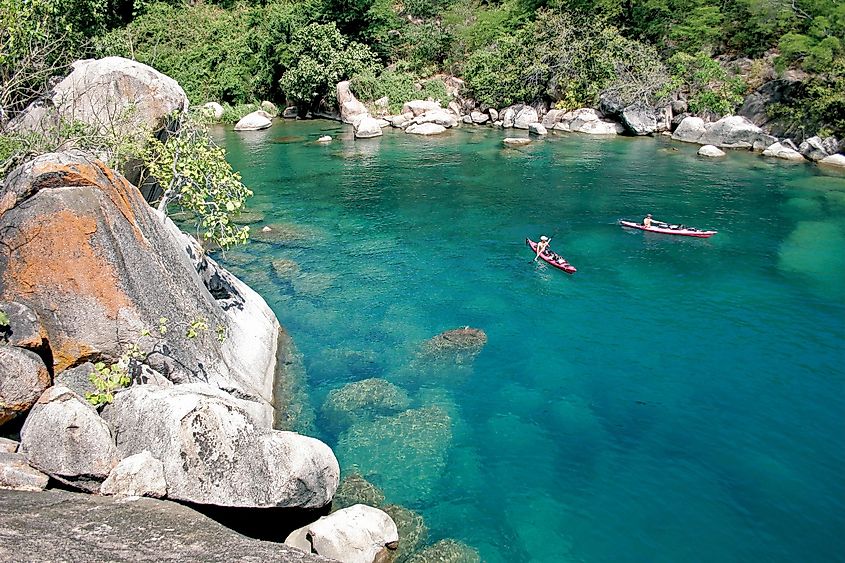
Covering an area of approximately 29,600 km2 (11,428 mi2), Lake Malawi is one of the African Great Lakes and holds more water than any other lake in the African Rift system. Interestingly, it is an ancient body of water, dating back 1-2 million years, and it is incredibly deep, reaching maximum depths of 706 meters (2,316 ft). Unlike Great Bear Lake, Lake Malawi has a significant human population along its shores, with local economies primarily based on fishing, particularly the endemic cichlid fish species.
One distinct geographic aspect of Lake Malawi is the presence of a massive rift valley, which serves as both a geographic and ecological demarcation. This rift has led to high levels of endemism (when a species is restricted to a single area) among its fish population, making it a hotspot for biological research on a unique species of crab and other creatures. Despite its large size, the lake is subject to pressures such as overfishing and pollution from nearby agriculture and settlements.
10. Great Slave Lake - 28,568 km2
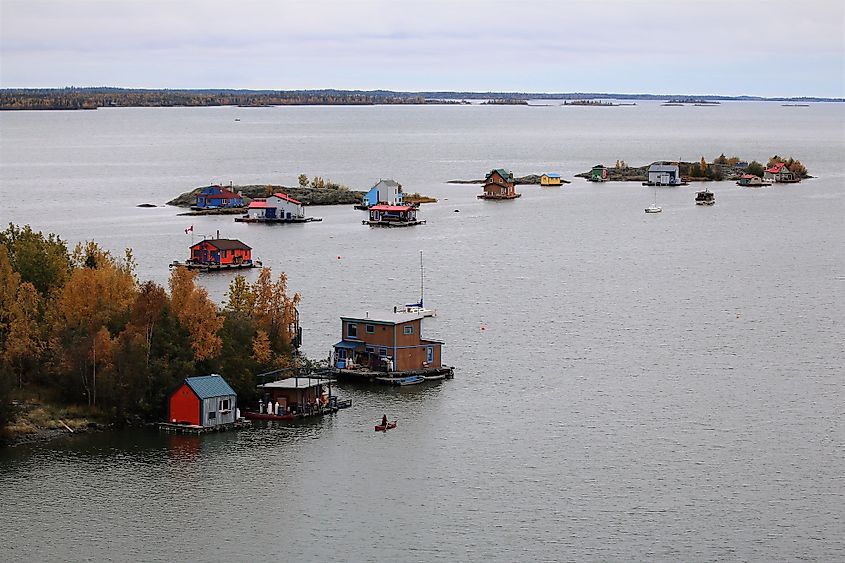
The naming is immediately unfortunate: it refers to the Cree name for the Dene people, who were an enslaved people group living on its southern shore several hundred years ago, around the mid-18th century. Setting that history aside, Great Slave Lake sits in Canada's Northwest Territories. It is the second-largest lake in the country and the deepest in North America, reaching depths of up to 614 meters (2,000 ft). Remember, the maximum depth does not equate to volume, and Lake Superior actually has signficantly more volume. Covering an area of approximately 28,568 km2 (11,030 mi2), the lake is vital to the flow of the Mackenzie River, which many Canadians rely on for all scopes of life. Great Slave Lake can be broadly categorized into two sections: the deeper, eastern section and the shallower, western section.
Great Slave Lake, in line with most (but not all) lakes of this collection, is a significant resource for fishing, and its shores contain several small communities and the city of Yellowknife, which relies on the lake for freshwater. Due to the intensity of a Canadian winter, the lake remains partially frozen for approximately eight months of the year, restricting boat travel and certain industrial activities. Thankfully, some truly incredible ice roads appear across the lake during winter months.
"One of NASA's guiding policies in the search for life is to follow the water." At the end of the day, the lakes of our world embody just how rare and special our planet is. Each of these bodies of water seems gargantuan, but remember, freshwater is literally a drop in the bucket compared to the less-amicable salt water in Earth's oceans. So, it is imperative that the conservation and preservation of these ecological wonders becomes a focus for the countries that host them; after all, they were around a long time before us, and with any luck, these amazing lakes will continue to exist for eons to come.
30 Largest Lakes In The World
| Rank | Name | Countries with shoreline | Area |
|---|---|---|---|
|
1 |
Caspian Sea |
Kazakhstan Russia Turkmenistan Azerbaijan Iran |
371,000 km2 |
|
2 |
Superior |
Canada United States |
82,103 km2 |
|
3 |
Victoria |
Uganda Kenya Tanzania |
68,484 km2 |
|
4 |
Huron |
Canada United States |
59,590 km2 |
|
5 |
Michigan |
United States |
57,753 km2 |
|
6 |
Tanganyika |
Burundi Tanzania Zambia Democratic Republic of the Congo |
32,900 km2 |
|
7 |
Baikal |
Russia |
31,722 km2 |
|
8 |
Great Bear Lake |
Canada |
31,328 km2 |
|
9 |
Malawi |
Malawi Mozambique Tanzania |
29,600 km2 |
|
10 |
Great Slave Lake |
Canada |
28,568 km2 |
|
11 |
Erie |
Canada United States |
25,700 km2 |
|
12 |
Winnipeg |
Canada |
24,514 km2 |
|
13 |
Ontario |
Canada United States |
18,960 km2 |
|
14 |
Ladoga |
Russia |
18,130 km2 |
|
15 |
Balkhash |
Kazakhstan |
16,400 km2 |
|
16 |
Bangweulu |
Zambia |
15,100 km2 |
|
17 |
Vostok |
Antarctica |
12,500 km2 |
|
18 |
Onega |
Russia |
9,700 km2 |
|
19 |
Titicaca |
Bolivia Peru |
8,372 km2 |
|
20 |
Nicaragua |
Nicaragua |
8,264 km2 |
|
21 |
Athabasca |
Canada |
7,850 km2 |
|
22 |
Turkana* |
Ethiopia Kenya |
6,405 km2 |
|
23 |
Reindeer Lake |
Canada |
6,330 km2 |
|
24 |
Issyk-Kul |
Kyrgyzstan |
6,200 km2 |
|
25 |
Urmia* |
Iran |
6,001 km2 |
|
26 |
Vänern |
Sweden |
5,545 km2 |
|
27 |
Winnipegosis |
Canada |
5,403 km2 |
|
28 |
Albert |
Uganda Democratic Republic of the Congo |
5,299 km2 |
|
29 |
Mweru |
Zambia Democratic Republic of the Congo |
5,120 km2 |
|
30 |
Nettilling |
Canada |
5,066 km2 |











